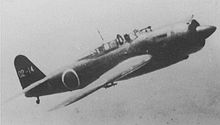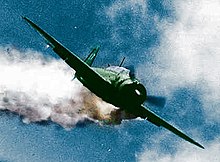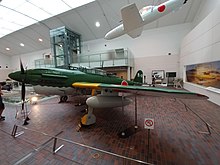Yokosuka D4Y
[1] While the aircraft was originally conceived as a dive bomber, the D4Y was used in other roles including reconnaissance, night fighter and special attack (kamikaze).
It made its combat debut as a reconnaissance aircraft when two pre-production D4Y1-Cs embarked aboard the Sōryū to take part in the Battle of Midway in 1942.
In October 1944, an attack by a lone D4Y resulted in the sinking of light carrier USS Princeton in the Battle of Leyte Gulf.
[4] Famously, a D4Y was used in one of the final kamikaze attacks in 1945, hours after the surrender of Japan, with Vice Admiral Matome Ugaki in the rear cockpit.
Development of the aircraft began in 1938 at the Yokosuka Naval Air Technical Arsenal when the Imperial Japanese Navy Aviation Bureau (Kaigun Kōkū Hombu) issued requirements of a Navy Experimental 13-Shi[a] Carrier Borne specification for an aircraft carrier-based dive bomber to replace the Aichi D3A.
[7] The aircraft was a single-engine, all-metal low-wing monoplane, with a wide-track retractable undercarriage and wing-mounted dive brakes.
[8] The aircraft was powered by an Aichi Atsuta liquid-cooled inverted V12 engine, a licensed copy of the German Daimler-Benz DB 601, rated at 895 kW (1,200 hp).
[9] In order to conform with the Japanese Navy's requirement for long range, weight was minimized by not fitting the D4Y with self-sealing fuel tanks or armour.
[11][12] After the prototype trials, problems with flutter were encountered, a fatal flaw for an airframe subject to the stresses of dive bombing.
[13] The last version was the D4Y4 Special Strike Bomber, a single-seat kamikaze aircraft, capable of carrying one 800 kg (1,800 lb) bomb, which was put into production in February 1945.
It was to be powered by the Nakajima NK9C Homare 12 radial engine rated at 1,361 kW (1,825 hp), a new four-blade metal propeller of the constant-speed type and more armour for the crew and fuel tanks.
The D4Y was operated from the following Japanese aircraft carriers: Chitose, Chiyoda, Hiyō, Junyō, Shinyo, Shōkaku, Sōryū, Taihō, Unryū, Unyō and Zuikaku.
The result was what the Americans called "The Great Marianas Turkey Shoot", with 400 Japanese aircraft shot down in a single day.
A month later on 25 November, USS Essex, Hancock, Intrepid and Cabot were hit by kamikazes, almost exclusively A6M Zero fighters and D4Ys, with much more damage.
Task Force 58 approached southern Japan in March 1945 to strike military objectives in support of the invasion of Okinawa.
The Japanese had begun installing rocket boosters on some Kamikazes, including the D4Y4, in order to increase speed near the target.
Each D4Y2-S had its bombing systems and equipment removed and replaced by a 20 mm Type 99 cannon installed in the rear cockpit, with the barrel slanted up and forwards in a similar manner to the German Schräge Musik armament fitting (pioneered by the IJNAS in May 1943 on the Nakajima J1N).
Among the last of these were eleven aircraft led by Vice Admiral Matome Ugaki on a suicide mission on 15 August 1945, of which all but three were lost.
[citation needed] [22][23] In 1988, a restored D4Y1 (serial 4316) was donated to the Yasukuni Shrine Yūshūkan Museum in Tokyo, where it remains on display.







